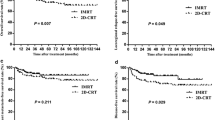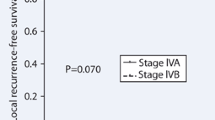Abstract
Objective
We compared treatment outcomes of two-dimensional radiotherapy (2D-RT), three-dimensional conformal radiotherapy (3D-CRT), and intensity-modulated radiotherapy (IMRT) in patients with nasopharyngeal carcinoma (NPC).
Patients and methods
In total, 1237 patients with cT1-4N0-3M0 NPC were retrospectively analyzed. Of these, 350, 390, and 497 were treated with 2D-RT, 3D-CRT, and IMRT, respectively.
Results
3D-CRT and IMRT showed better 5-year overall survival (OS) rates (73.6 and 76.7 %, respectively) than did 2D-RT (5-year OS of 59.7 %, all p < 0.001). In T3–4 subgroup, IMRT was associated with a significantly better 5-year OS than was 2D-RT (70.7 vs. 50.4 %, respectively; p ≤ 0.001) and 3D-CRT (70.7 vs. 57.8 %, respectively; p = 0.011); however, the difference between the 2D-RT and 3D-CRT groups did not reach statistical significance (p = 0.063). In multivariate analyses of all patients, IMRT was a predictive factor for OS when compared with 2D-RT or 3D-CRT, as was 3D-CRT when compared with 2D-RT.
Conclusion
Our study showed that 3D-CRT and IMRT were associated with a better local progression-free survival and OS than was 2D-RT in NPC. IMRT was significantly superior in terms of OS for advanced primary tumors (T3–4).
Zusammenfassung
Zielsetzung
Wir verglichen die Behandlungsergebnisse von zweidimensionaler Strahlentherapie (2D-RT), dreidimensionaler konformer Strahlentherapie (3D-CRT) und intensitätsmodulierter Strahlentherapie (IMRT) bei Patienten mit Nasopharynxkarzinom (NPC).
Patienten und Methoden
Insgesamt 1237 Patienten mit NPC im Stadium cT1–4/N0–3/M0 wurden rückwirkend analysiert. Von diesen wurden jeweils 350, 390 und 497 mit 2D-RT, 3D-CRT und IMRT behandelt.
Ergebnisse
3D-CRT und IMRT zeigten eine bessere 5-Jahres-Gesamtüberlebensrate (5y-OS; jeweils 73,6 und 76,7%) als 2D-RT (59,7%; alle p < 0,001). In der Untergruppe T3–4 war die IMRT mit einer erheblich besseren 5y-OS verbunden als 2D-RT (jeweils 70,7 vs. 50,4%; p ≤ 0,001) und 3D-CRT (jeweils 70,7 vs. 57,8%; p = 0,011); jedoch gab es keinen Unterschied zwischen den Gruppen 2D-RT und 3D-CRT(p = 0,063). In multivariater Analyse von allen Patienten war die IMRT ein prädiktiver Faktor für das OS im Vergleich mit 2D-RT oder 3D-CRT, hingegen 3D-CRT verglichen mit 2D-RT.
Schlussfolgerung
Unsere Studie zeigte, dass 3D-CRT und IMRT mit dem lokalen progressionsfreien Überleben und OS besser verbunden sind als 2D-RT in NPC. IMRT war erheblich überlegen in Bezug auf das OS für fortgeschrittene primäre Tumoren (T3–4).



Similar content being viewed by others
References
Al-Sarraf M, LeBlanc M, Giri PG et al (1998) Chemoradiotherapy versus radiotherapy in patients with advanced nasopharyngeal cancer: phase III randomized Intergroup study 0099. J Clin Oncol 16:1310–1317
Baujat B, Audry H, Bourhis J et al (2006) Chemotherapy in locally advanced nasopharyngeal carcinoma: an individual patient data meta-analysis of eight randomized trials and 1753 patients. Int J Radiat Oncol Biol Phys 64:47–56. doi:10.1016/j.ijrobp.2005.06.037
Chan AT, Leung SF, Ngan RK et al (2005) Overall survival after concurrent cisplatin-radiotherapy compared with radiotherapy alone in locoregionally advanced nasopharyngeal carcinoma. J Natl Cancer Inst 97:536–539. doi:10.1093/jnci/dji084
Chen L, Hu CS, Chen XZ et al (2012) Concurrent chemoradiotherapy plus adjuvant chemotherapy versus concurrent chemoradiotherapy alone in patients with locoregionally advanced nasopharyngeal carcinoma: a phase 3 multicentre randomised controlled trial. Lancet Oncol 13:163–171. doi:10.1016/S1470-2045(11)70320-5
Kwong DL, Sham JS, Au GK et al (2004) Concurrent and adjuvant chemotherapy for nasopharyngeal carcinoma: a factorial study. J Clin Oncol 22:2643–2653. doi:10.1200/JCO.2004.05.173
Lee AW, Tung SY, Chan AT et al (2011) A randomized trial on addition of concurrent-adjuvant chemotherapy and/or accelerated fractionation for locally-advanced nasopharyngeal carcinoma. Radiother Oncol 98:15–22. doi:10.1016/j.radonc.2010.09.023
Lee AW, Tung SY, Chua DT et al (2010) Randomized trial of radiotherapy plus concurrent-adjuvant chemotherapy vs radiotherapy alone for regionally advanced nasopharyngeal carcinoma. J Natl Cancer Inst 102:1188–1198. doi:10.1093/jnci/djq258
Wee J, Tan EH, Tai BC et al (2005) Randomized trial of radiotherapy versus concurrent chemoradiotherapy followed by adjuvant chemotherapy in patients with American Joint Committee on Cancer/International Union against cancer stage III and IV nasopharyngeal cancer of the endemic variety. J Clin Oncol 23:6730–6738. doi:10.1200/JCO.2005.16.790
Blanchard P, Lee A, Marguet S et al (2015) Chemotherapy and radiotherapy in nasopharyngeal carcinoma: an update of the MAC-NPC meta-analysis. Lancet Oncol 16:645–655. doi:10.1016/S1470-2045(15)70126-9
Kam MK, Leung SF, Zee B et al (2007) Prospective randomized study of intensity-modulated radiotherapy on salivary gland function in early-stage nasopharyngeal carcinoma patients. J Clin Oncol 25:4873–4879. doi:10.1200/JCO.2007.11.5501
Pow EH, Kwong DL, McMillan AS et al (2006) Xerostomia and quality of life after intensity-modulated radiotherapy vs. conventional radiotherapy for early-stage nasopharyngeal carcinoma: initial report on a randomized controlled clinical trial. Int J Radiat Oncol Biol Phys 66:981–991. doi:10.1016/j.ijrobp.2006.06.013
Lee N, Xia P, Quivey JM et al (2002) Intensity-modulated radiotherapy in the treatment of nasopharyngeal carcinoma: an update of the UCSF experience. Int J Radiat Oncol Biol Phys 53:12–22
Fang FM, Chien CY, Tsai WL et al (2008) Quality of life and survival outcome for patients with nasopharyngeal carcinoma receiving three-dimensional conformal radiotherapy vs. intensity-modulated radiotherapy-a longitudinal study. Int J Radiat Oncol Biol Phys 72:356–364. doi:10.1016/j.ijrobp.2007.12.054
Lai SZ, Li WF, Chen L et al (2011) How does intensity-modulated radiotherapy versus conventional two-dimensional radiotherapy influence the treatment results in nasopharyngeal carcinoma patients? Int J Radiat Oncol Biol Phys 80:661–668. doi:10.1016/j.ijrobp.2010.03.024
Lee AW, Ng WT, Chan LL et al (2014) Evolution of treatment for nasopharyngeal cancer—success and setback in the intensity-modulated radiotherapy era. Radiother Oncol 110:377–384. doi:10.1016/j.radonc.2014.02.003
Peng G, Wang T, Yang KY et al (2012) A prospective, randomized study comparing outcomes and toxicities of intensity-modulated radiotherapy vs. conventional two-dimensional radiotherapy for the treatment of nasopharyngeal carcinoma. Radiother Oncol 10486–293. doi:10.1016/j.radonc.2012.08.013
Jung KW, Park S, Kong HJ et al (2011) Cancer statistics in Korea: incidence, mortality, survival, and prevalence in 2008. Cancer Res Treat 43:1–11. doi:10.4143/crt.2011.43.1.1
Lee AW, Lau WH, Tung SY et al (2005) Preliminary results of a randomized study on therapeutic gain by concurrent chemotherapy for regionally-advanced nasopharyngeal carcinoma: NPC-9901 Trial by the Hong Kong Nasopharyngeal Cancer Study Group. J Clin Oncol 23:6966–6975. doi:10.1200/JCO.2004.00.7542
Cox JD, Stetz J, Pajak TF (1995) Toxicity criteria of the Radiation Therapy Oncology Group (RTOG) and the European Organization for Research and Treatment of Cancer (EORTC). Int J Radiat Oncol Biol Phys 31:1341–1346. doi:10.1016/0360-3016(95)00060-C
Jen YM, Shih R, Lin YS et al (2005) Parotid gland-sparing 3-dimensional conformal radiotherapy results in less severe dry mouth in nasopharyngeal cancer patients: a dosimetric and clinical comparison with conventional radiotherapy. Radiother Oncol 75:204–209. doi:10.1016/j.radonc.2005.03.005
Corry J, Hornby C, Fisher R et al (2004) ‘Boomerangʼ technique: an improved method for conformal treatment of locally advanced nasopharyngeal cancer. Australas Radiol 48:170–180. doi:10.1111/j.1440-1673.2004.01293.x
Lee AW, Lin JC, Ng WT (2012) Current management of nasopharyngeal cancer. Semin Radiat Oncol 22:233–244. doi:10.1016/j.semradonc.2012.03.008
Cheng SH, Yen KL, Jian JJ et al (2001) Examining prognostic factors and patterns of failure in nasopharyngeal carcinoma following concomitant radiotherapy and chemotherapy: impact on future clinical trials. Int J Radiat Oncol Biol Phys 50:717–726
Ou SH, Zell JA, Ziogas A, Anton-Culver H (2005) Epidemiology of nasopharyngeal carcinoma in the United States: improved survival of Chinese patients within the keratinizing squamous cell carcinoma histology. Ann Oncol 18:29–35. doi:10.1093/annonc/mdl320
Acknowledgments
The authors would like to thank Jihye Cha, M.D., Jae Myoung Noh, M.D., Won Taek Kim, M.D., Young Taek Oh, M.D., Min Kyu Kang, M.D., Jin hee Kim, M.D., Ji-Yoon Kim, M.D., and Sung Whan Kim, M.D. for contribution. Supported by NCC Grant No.1310070 from National Cancer Center.
Author information
Authors and Affiliations
Corresponding author
Ethics declarations
Conflict of interest
S.H. Moon, K.H. Cho, C.-G. Lee, K. C. Keum, Y.-S. Kim, H.-G. Wu, J.H. Kim, Y.C. Ahn, D. Oh, and J.H. Lee state that there are no conflicts of interest.
The accompanying manuscript does not include studies on humans or animals.
Rights and permissions
About this article
Cite this article
Moon, S.H., Cho, K.H., Lee, CG. et al. IMRT vs. 2D-radiotherapy or 3D-conformal radiotherapy of nasopharyngeal carcinoma. Strahlenther Onkol 192, 377–385 (2016). https://doi.org/10.1007/s00066-016-0959-y
Received:
Accepted:
Published:
Issue Date:
DOI: https://doi.org/10.1007/s00066-016-0959-y




